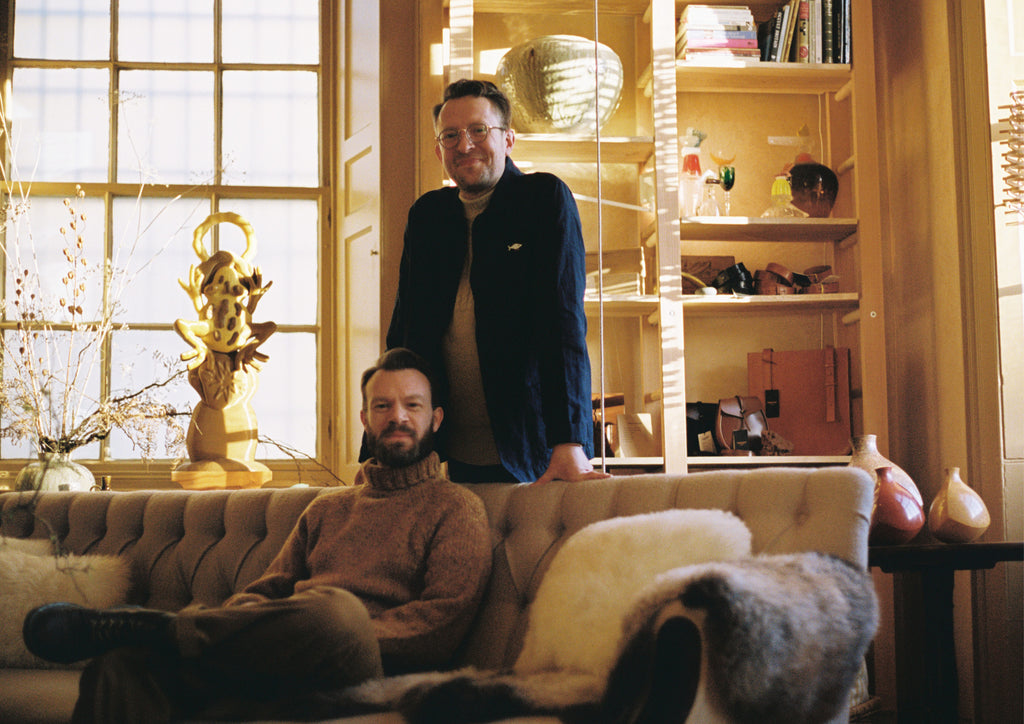
At Bard, a new gallery and shop in Leith, Edinburgh, you’ll find an assortment of objects that together tell a richly detailed story about Scottish craft and design – what it is, how it got here, where it’s headed. It traces willow weaving on the Isle of Eigg and seaweed harvesting on beaches closer to home. Knitting in Shetland and woodwork in Orkney. There are flowerpots made from recycled sea plastic and stoneware mugs with a special ‘scrub-ash’ glaze. It’s a story of people and places.
Hugo Macdonald, who grew up on the Isle of Skye, and his husband, James Stevens, spent much of the past decade travelling around Scotland. “We knew we would move here one day, but we were keen to do so with purpose,” says Hugo, who has worked in design journalism, consultancy and curation. “For years we’d been searching for somewhere that showcased the breadth of Scottish craftsmanship and design under one roof and struggled to find it,” explains Hugo. “In Edinburgh there was nothing really beyond the shops selling tartan and shortbread and whisky.” And so, they decided to do it themselves.

The pair put their home in Hastings, East Sussex on the market, and it was while looking for somewhere to live in Edinburgh that they came across Scotland’s oldest Custom House, overlooking the Water of Leith. “It was traditionally an area of making and commerce, so it felt like a comfortable fit,” says James, who trained as an architect and formerly worked at London’s architectural-salvage experts Retrouvius. “As a port, it was historically the place where the world met Edinburgh, and where Edinburgh met the world.” After thriving in the 18th and 19th centuries, and falling into disrepair in the 20th, today it’s a hotbed of young creative spirit home to graphic designers, photographers, architects.
Now, every good story involves a journey of sorts, and before they got to work on the refurbishment, Hugo, James and their beloved dog, Dougal, hopped in the car (and boarded a few ferries) and spent three months touring Scotland. “Nothing replaces the magic of standing in someone’s studio, properly understanding who they are, what they do and why they do it,” says Hugo. “It was important that we visited the makers ourselves before we took a bit of them into Bard and communicated it to a wider audience.”
Their travels took them across the length and breadth of Scotland, from the Borders up to the Western Isles, to Orkney and Shetland. On the Isle of Skye they met Roger and Andrea Holden, who, on bicycle pedal-powered looms, weave blankets, scarves, throws and tweed with wool sourced from local Skye sheep. On the Isle of Eigg, one of the Inner Hebrides islands to the south of Skye, they spent time with Catherine Davies and Pascal Carr, who grow and harvest willow and with it make traditional and contemporary baskets. “These little pockets of ingenuity and expertise exist all over Scotland,” says Hugo.


Back in Leith, such items appear on a medley of old oak furnishings, the idea being that the Scottish aesthetic isn’t singular or restricted to a particular period. After settling on a vision for the space being a collector’s home, James got to work conjuring a feeling of homeliness, with burnt sienna walls on the ground floor and a French ochre that effortlessly catches the light upstairs. “We hope it feels domestic rather than too shop or gallery-like,” he says. “It can be a big mental leap to take something off a plinth and imagine it on your dresser – we want people to better understand what it’s like to live with these things.”
Although the pieces are displayed in what Hugo describes as “the least curated way possible”, he and James are often told by visitors that they have good taste. “But that’s not the point,” says Hugo. “It’s all about the people we’re working with, and making space for these things to exist together in a way that encourages conversations.” Rather than selling an aesthetic or a lifestyle, Bard celebrates the fact that making, designing and manufacturing in Scotland are thriving. Far from a cautionary tale of shuttered stores and tightened purse strings, this is an optimistic story of brands and companies that are simultaneously preserving and evolving traditional skills.
By now, Hugo and James have found somewhere to live – a fishing merchant’s house a 20-minute walk along the coast in Newhaven. “It’s an older building, so it will need and respond to other things, but we’re keen to use it as an opportunity to commission the makers we’re working with,” says James.

They’re also busy planning an exhibition – 100 x 100 – which will open at Bard in July. They’ve asked 100 Scots of all ages and backgrounds to choose one object each that for them embodies Scottishness. “It’s a bit like a cultural census,” says Hugo. “We’re trying to bring together a broad collection of things into Bard and say, ‘All this and so much more is Scottishness,’ because cultural identity is a deeply personal jigsaw puzzle in many ways.”
Interview by Chloë Ashby.
Photographs by Alice Meikle.
Discover more about Bard, the gallery and shop for Scottish craft and design in Leith, Edinburgh.
James wears our Donegal Roll Neck Sweater and Dylan Canvas Carpenter Trousers, while Hugo wears our Fair Isle Wool Cotton Sweater, Gansey Yoke Wool Cotton Sweater and Garment Dyed Herringbone Jacket.
Add a comment
2 comments